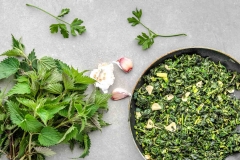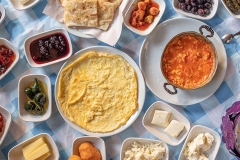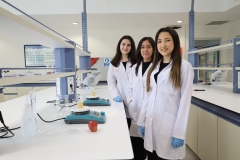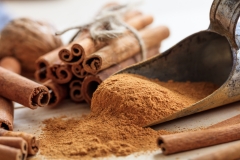
FACULTY OF ENGINEERING
Department of Food Engineering
FE 430 | Course Introduction and Application Information
| Course Name |
Shelf-life of Food Products
|
|
Code
|
Semester
|
Theory
(hour/week) |
Application/Lab
(hour/week) |
Local Credits
|
ECTS
|
|
FE 430
|
Fall/Spring
|
3
|
0
|
3
|
5
|
| Prerequisites |
None
|
|||||
| Course Language |
English
|
|||||
| Course Type |
Elective
|
|||||
| Course Level |
First Cycle
|
|||||
| Mode of Delivery | - | |||||
| Teaching Methods and Techniques of the Course | - | |||||
| Course Coordinator | ||||||
| Course Lecturer(s) | ||||||
| Assistant(s) | - | |||||
| Course Objectives | The purpose of this course is to provide students with the necessary fundamental knowledge related to storage stability and shelf life of food products and skills of solving engineering problems. |
| Learning Outcomes |
The students who succeeded in this course;
|
| Course Description | This course will cover; The definition of shelf life; Factors affecting shelf-life and spoilage; Determination of shelf life; Simulation models to predict the shelf life of foods; Predicting packaging characteristics to improve shelf life of various foods; Accelerated shelf life analysis;Shelf life and expiration date of confectionery products, snack foods, bakery products, milk and dairy products, meat and processed meat products. |
|
|
Core Courses | |
| Major Area Courses |
X
|
|
| Supportive Courses | ||
| Media and Management Skills Courses | ||
| Transferable Skill Courses |
WEEKLY SUBJECTS AND RELATED PREPARATION STUDIES
| Week | Subjects | Related Preparation |
| 1 | The shelf life definition | Understanding and measuring the shelf-life of food. Steele R. 2004, Woodhead Publishing, Chapter 1. |
| 2 | Factors affecting shelf-life and spoilage | Understanding and measuring the shelf-life of food. Steele R. 2004, Woodhead Publishing, Chapter 01. |
| 3 | The water activity concept. Moisture management | Understanding and measuring the shelf-life of food. Steele R. 2004, Woodhead Publishing, Chapter 2. |
| 4 | Microbiological, physical, chemical, and biochemical decomposition types and mechanisms in foods | Understanding and measuring the shelf-life of food. Steele R. 2004, Woodhead Publishing, Chapter 3-4. |
| 5 | Sensory evaluation methods for shelf life assessment | Understanding and measuring the shelf-life of food. Steele R. 2004, Woodhead Publishing. Chapter 5. |
| 6 | Phase transition, crystallization, staling, lipid oxidation, maillard reactions, | Understanding and measuring the shelf-life of food. Steele R. 2004, Woodhead Publishing. Chapter 6-7. |
| 7 | Enzymatic reactions, protein stability, color stability, crispness stability | Understanding and measuring the shelf-life of food. Steele R. 2004, Woodhead Publishing, Chapter 8. |
| 8 | Midterm exam | |
| 9 | Determination of shelf life | Understanding and measuring the shelf-life of food. Steele R. 2004, Woodhead Publishing, Chapter 9. |
| 10 | The shelf life estimation based on time-temperature relation in manufacturing | Understanding and measuring the shelf-life of food. Steele R. 2004, Woodhead Publishing, Chapter 9. |
| 11 | Simulation models to predict the shelf life of foods | Understanding and measuring the shelf-life of food. Steele R. 2004, Woodhead Publishing, Chapter 10, 14-15. |
| 12 | Predicting packaging characteristics to improve shelf life of various foods | Understanding and measuring the shelf-life of food. Steele R. 2004, Woodhead Publishing Chapter 14-15. |
| 13 | Accelerated shelf life analysis | Understanding and measuring the shelf-life of food. Steele R. 2004, Woodhead Publishing, Chapter 14-15. |
| 14 | Shelf life and expiration date of confectionery products, snack foods, bakery products, milk and dairy products, meat and processed meat products | Understanding and measuring the shelf-life of food. Steele R. 2004, Woodhead Publishing, Chapter 16. |
| 15 | Project presentation | |
| 16 | Overall review | Understanding and measuring the shelf-life of food. Steele R. 2004, Woodhead Publishing, Chapter 1-16. |
| Course Notes/Textbooks | Understanding and measuring the shelf-life of food. Steele R. 2004, Woodhead Publishing |
| Suggested Readings/Materials | Food Science. 5th Edition. Edited by Norman N. Potter, Joseph H. Hotchkiss. Chapman & Hall. 1995 Food shelf life stability: chemical, biochemical, and microbiological changes. Eskin M., Robinson D.S. 2000. CRC Press, Taylor & Francis, Boca Raton, Florida,USA. The Stability and Shelf-life of Food. Kilcast D., Subramamiam P. 2000. Woodhead Publishing. Shelf life evaluation of foods. Man D.,Jones A. 2000. Aspen Publishers |
EVALUATION SYSTEM
| Semester Activities | Number | Weigthing |
| Participation | ||
| Laboratory / Application | ||
| Field Work | ||
| Quizzes / Studio Critiques | ||
| Portfolio | ||
| Homework / Assignments | ||
| Presentation / Jury |
1
|
20
|
| Project |
1
|
20
|
| Seminar / Workshop | ||
| Oral Exams | ||
| Midterm |
1
|
30
|
| Final Exam |
1
|
30
|
| Total |
| Weighting of Semester Activities on the Final Grade |
3
|
70
|
| Weighting of End-of-Semester Activities on the Final Grade |
1
|
30
|
| Total |
ECTS / WORKLOAD TABLE
| Semester Activities | Number | Duration (Hours) | Workload |
|---|---|---|---|
| Theoretical Course Hours (Including exam week: 16 x total hours) |
16
|
3
|
48
|
| Laboratory / Application Hours (Including exam week: '.16.' x total hours) |
16
|
0
|
|
| Study Hours Out of Class |
16
|
3
|
48
|
| Field Work |
0
|
||
| Quizzes / Studio Critiques |
0
|
||
| Portfolio |
0
|
||
| Homework / Assignments |
0
|
||
| Presentation / Jury |
1
|
12
|
12
|
| Project |
1
|
12
|
12
|
| Seminar / Workshop |
0
|
||
| Oral Exam |
0
|
||
| Midterms |
1
|
10
|
10
|
| Final Exam |
1
|
20
|
20
|
| Total |
150
|
COURSE LEARNING OUTCOMES AND PROGRAM QUALIFICATIONS RELATIONSHIP
|
#
|
Program Competencies/Outcomes |
* Contribution Level
|
||||
|
1
|
2
|
3
|
4
|
5
|
||
| 1 | Being able to transfer knowledge and skills acquired in mathematics and science into engineering, | X | ||||
| 2 | Being able to identify and solve problem areas related to Food Engineering, | X | ||||
| 3 | Being able to design projects and production systems related to Food Engineering, gather data, analyze them and utilize their outcomes in practice, | X | ||||
| 4 | Having the necessary skills to develop and use novel technologies and equipment in the field of food engineering, |
X | ||||
| 5 | Being able to take part actively in team work, express his/her ideas freely, make efficient decisions as well as working individually, |
X | ||||
| 6 | Being able to follow universal developments and innovations, improve himself/herself continuously and have an awareness to enhance the quality, |
|||||
| 7 | Having professional and ethical awareness, |
|||||
| 8 | Being aware of universal issues such as environment, health, occupational safety in solving problems related to Food Engineering, | |||||
| 9 | Being able to apply entrepreneurship, innovativeness and sustainability in the profession, |
|||||
| 10 | Being able to use software programs in Food Engineering and have the necessary knowledge and skills to use information and communication technologies that may be encountered in practice (European Computer Driving License, Advanced Level), |
X | ||||
| 11 | Being able to gather information about food engineering and communicate with colleagues using a foreign language ("European Language Portfolio Global Scale", Level B1) |
X | ||||
| 12 | Being able to speak a second foreign language at intermediate level. |
|||||
| 13 | Being able to relate the knowledge accumulated during the history of humanity to the field of expertise |
X | ||||
*1 Lowest, 2 Low, 3 Average, 4 High, 5 Highest
NEWS |ALL NEWS

Online 'weight loss' period
The increase in time spent at home to protect against coronavirus and the habit of sedentary life caused a "weight" crisis for

The Aegean is distributing healing
The fear of catching coronavirus, which is transmitted to more than 73 million people worldwide, and the increase in flu cases with

Pandemic changed eating habits
The coronavirus, which negatively affected life in many issues from daily life to work and social interaction, also changed the eating habits

HIGH-SCHOOL STUDENTS EXPERIENCED COLLEGE IN FOOD ENGINEERING LABORATORIES
“SCIENCE DAYS” event was organized by Department of Food Engineering in Izmir University of Economics. This event aimed to teach science in

STUDENTS OF FOOD ENGINEERING DEPARTMENT DEVELOPED 'ATRICHOKE PASTE' FOR FIRST INTERNATIONAL URLA ARTICHOKE FESTIVAL
Most of the attenders enjoyed the 'Artichoke Paste', developed by the students of Food Engineering Department.

MAINTAINING HEALTHY EATING HABITS DURING HOLIDAY SEASON!
As the students got their report cards and started a long summer holiday, the experts pointed out the importance of not to


